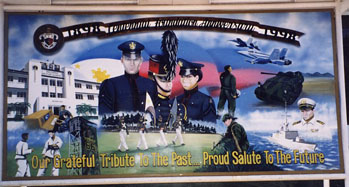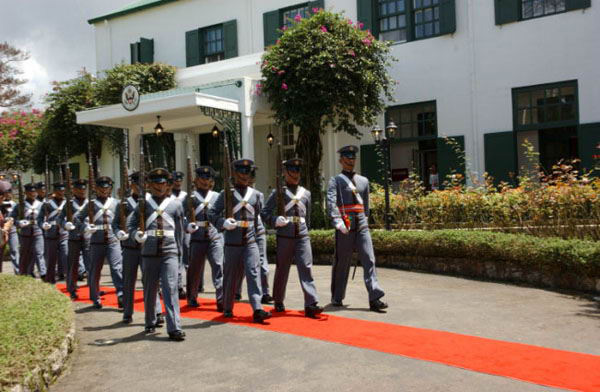Fabulous Philippines > Baguio City > Philippine Military Academy
Philippine Military Academy
Baguio City

Handpainted sign at the Philippine Military Academy, Baguio
Share this page:
The United States has its top military academy at West Point; and in the Philippines the top military school is the Philippine Military Academy (or PMA).
The Philippine Military Academy trains the future officers of the Philippine Army, Navy, and Air Force, in accordance with the mission statement: "To instruct, train, and develop the cadets so that they will possess the character, the broad and basic military skills, and the education essential to the pursuit of a progressive military career."
The PMA is located at the Fort del Pilar, Loakan, which is just 10 kilometers (6 miles) from Baguio City.
The PMA is a popular tourist attraction. It is open for visits during daylight hours, seven days a week. On Saturday mornings the Cadet Corps have a parade and review, including the always impressive precision marching.

Philippine Military Academy cadets marching in traditional uniforms
History of the PMA
The PMA traces its roots back to the Academia Militar (Spanish, "Military Academy") that was founded on 25 October 1898 in Malacos, Bulacan, Philippines during the administration of President Emilio Aguinaldo.
That was the time of the first (??) Philippine Republic.
Unfortunately, due to increasing hostilities between the Filipino and the invading Americans, the Academia Militar had to close on 20 January 1899, after just four months of operation.
Then in 1905, during the period of American colonial rule, a Philippine Constabulary Officers’ School was set up in Intramuros (the old walled city of Manila).
In 1908 this School was relocated to Baguio – at Constabulary Hill (later renamed Camp Henry T. Allen).
In 1926 the Philippine Legislature passed Act No. 3496 which renamed the school the Philippine Constabulary Academy (PCA), lengthened the courses to three years and revised the curriculum.
In 1935, at the beginning of the Philippine Commonwealth (??), the Commonwealth Act No. 1 (also known as the National Defense Act) was passed. This law renamed the school the Philippine Military Academy (or PMA in short) and authorized it to award a Bachelor of Science degree to PMA graduates after their successful completion of a four year course of study.
The PMA was patterned on the United States Military Academy at West Point, New York state, and officers from both the Philippines (Philippine Scouts) and the United States Army were appointed as staff members and instructors.
In December 1941, World War II came to the Philippines. This disrupted the PMA’s classes: the classes of 1942 and 1943 were graduated prematurely (that is, before they had completed their courses) and the classes of 1944 and 1945 were sent home. However, members of all of these classes fought during the war (in Bataan and other places across the Philippines) and sadly many of them died during the war.
In 1947 the PMA reopened again at Camp Henry T. Allen, Baguio, and then in 1950, due to the increased need for larger grounds, the PMA relocated to to its present site at Fort Gregorio H. del Pilar, at Loakan, about 10 km from Baguio. The current site has 373 hectares. It is named after General Gregorio del Pilar, a Filipino general and hero of the Battle of Tirad Pass (2 December 1899) against the Americans.
At this time the curriculum was mostly technically oriented (science, engineering and military studies) but in the 1960s socio-humanistic courses were added to the curriculum with the goal that officers would receive a well-rounded education.
The PMA’s current philosophy of education is as follows:
PMA adopts a holistic view of man as body, soul, and spirit. PMA believes that future leaders can be selected, formed, and developed to their fullest potentials. PMA is principally an institution for military leadership and it is from the total view of man that PMA’s leader development program is based. It contains character development, a balanced college education, military leadership, and physical development, necessary to prepare the cadets for the profession of arms and to be responsive to the needs of the Armed Forces and the Nation.
In 1993 the PMA became a Tri-Service Academy, with specialist courses and training based on branch of service (Army, Navy, or Air Force) being introduced. These courses and and training were undertaken by cadets during their final two years of training in the Academy.
Also in 1993, in accordance with the Republic Act 7192 on the "Women in Development and Nation Building Act", the first female cadets were admitted to the PMA. The first female cadets graduated in 1997 and in 1999 the first female cadet achieved the distinction of graduating at the top of her class (she was Arlene S. Dela Cruz).
Share this page:
Author: David Paul Wagner
(David Paul Wagner on Google+)
|